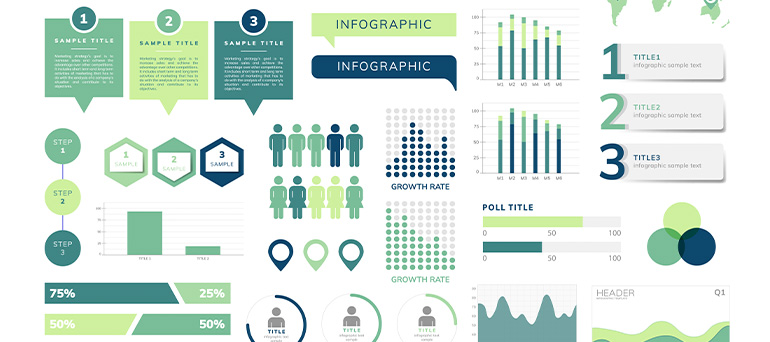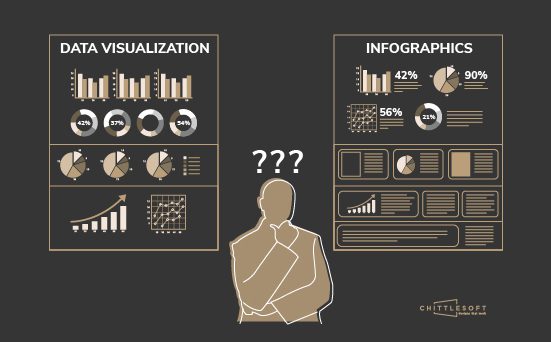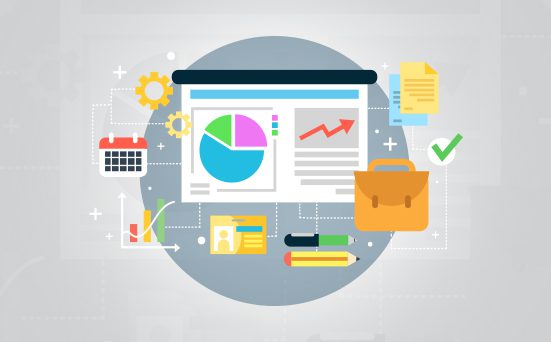
“Hear a piece of information, and three days later you’ll remember 10% of it. Add a picture and you’ll remember 65%.” – Brain Rules, John Medina.
This quote by John Medina explains why content marketing infographics have been successfully used by companies for several years. A 2022 content marketing report mentioned that 70% of B2B marketers incorporated them into their strategy.
What makes content marketing infographics such a winner? A major reason is that they are versatile and can be easily adapted to meet different marketing objectives.
A quality, visually-appealing infographic can be an incredible asset for your sales and marketing strategy, if used well. With good design, content marketing infographics are engaging and make complex concepts or information easy to understand.
Learn how good design transforms data into impactful infographics.
5 benefits of using content marketing infographics
Incorporate content marketing infographics into your long-term content marketing strategy to see improved performance in these areas:
1. SEO
Infographics are a good way to create more backlinks to your website and can get you great results in the SEO department if you are careful to optimize them. To ensure your content marketing infographic is SEO-friendly, start with its name. What you call it matters to Google, making keyword research a must.
Tip: Try a long-tail keyword that summarizes the message the image is conveying.
Similarly, it is important to use all opportunities to add relevant text, such as your alt text, URL, H1 tags, meta description, and supporting text. Choosing an image format that will load quickly will further your SEO efforts.
2. Website traffic
Compelling visuals spark interest. When used to describe your products, they can prompt your online audience to learn more about you and your work. Direct traffic to your website with easy-to-follow content marketing infographics by placing them strategically in guest blogs or social media posts, for example.
Be sure to use a clear call to action and explore as many relevant platforms as you can to attract traffic from a variety of sources.
Read more on increasing website traffic with infographics.
3. Average time on page
In addition to getting people to your page, content marketing infographics can make staying on your page an attractive option. They can explain ideas of varying complexities while keeping the viewer engaged and scrolling.
Their purpose is to inform rather than to hard-sell, making it more appealing for someone interested in the content to spend time on your page, increasing your average time on page.
To sum up, it’s a great way to get people to actually read your content.
4. Brand awareness
When they are well-designed and well-written, content marketing infographics can be highly shareable, and can help you spread your message creatively and effectively.
While infographics are informative and not promotional, they can still help promote your brand when you present quality information in an engaging and easy-to-understand format that your audience would love to share across their network.
5. Expertise and authority
Because content marketing infographics allow you to present insights and other information specific to your area of expertise, they can encourage your audience to view you as a knowledgeable and reliable source of useful insights and information in your niche.
How to create an eye-catching infographic
Here are some things you can do to create eye-catching content marketing infographics:
- Avoid information overload. Infographics can break down complex ideas, but they can easily become overcomplicated. If the data is not selected and conveyed strategically, they can appear disorganized. The viewer may see them as more trouble than they’re worth, and click away.
- Pick a topic and stick to it. It may be tempting to cram in as many facts and figures as possible while you’re at it, but creating an infographic will require some discernment. A single, clear message supported by relevant information is preferable.
- Factor in font size and image size. Ensure that nothing is lost in the resizing when the infographic goes from designer to developer. It is also important to design it to be a manageable size.
- Keep it clean. Visually, having a clean layout with adequate white space and crisp text will make the infographic visually appealing. Icons and visuals should also be high-quality and clean. To get people to read your infographic, make it look easy and low-effort to do so.
- Say it with visuals. Wherever possible, use visuals instead of text to convey your points. Use interesting illustrations and visuals to explain what you are talking about, rather than explaining it in text.
- Stick to your brand guidelines. As with all your sales and marketing collateral, it’s important to ensure your infographics are created in line with your brand guidelines. The images, typography, colors, and overall look and feel should align with your brand’s visual guidelines.
Where can you share infographics to promote your brand?
There are many ways to share your content marketing infographics with your target audience. You can publish them on your company’s social media channels and blog. You can also use them as emailers, sent to your database or subscribers who already recognize you as an expert in your field. Additionally, you can submit your infographics to infographic submission sites to boost your reach, shares, and backlinks.
Infographics can be valuable, memorable, high-ROI pieces of marketing collateral that delight your target audience—if the design and content express your insights well.
Does your data have a story to tell? We can help you tell it! Call us to find out how we can present your data or concept creatively and effectively as an infographic.




